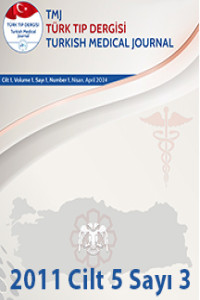Abstract
Amaç: Spinal disrafizm (SD) şüphesi olan olgularda, manyetik resonans görüntüleme (MRG)’nin spinal malformasyonları saptamada ve sınıflandırmadaki etkinliğinin değerlendirilmesi amaçlanmıştır.
Gereç-yöntem: 3 gün ile 20 yaş aralığındaki spinal disrafizm şüphesi veya ön tanısı ile 40 hastaya spinal MRG tetkiki gerçekleştirildi. 40 hastanın 23’ü MRG tetkiki sonrası opere oldu. Operasyon ile MRG bulguları karşılaştırıldı. 40 hastanın 11’ine ultrason (US) tetkiki uygulandı. US incelemeleri lineer prob ile aksiyal ve sagital planda gerçekleştirildi. Posterior
eleman ossifikasyonu tamamlanan hastalara ve retrospektif olarak çalışmaya dahil edilen hastalara US tetkiki uygulanamadı. US bulguları ile MRG sonuçları karşılaştırıldı.
Bulgular; 40 hastanın 27’si (% 67.5) kadın, 13’ü(% 32.5) erkekti. 14 (% 35) olguda açık SD, 26 (%65’) olguda kapalı SD saptandı. Kapalı SD saptanan 26 olgunun 15’inde (%57.7) kutanöz bulgular mevcuttu.
40 hastanın lezyon dağılımı; (5) lipomyelosel, (2) lipomyelomeningosel, (14) myelomeningosel (MM), (18) tethered kord, (11) diastematomiyeli (DMM) (3) dermal sinüs trakt (DST),
(2) filum terminale, (9) siringohidromyeli, (5) hemivertebra, (2) kelebek vertebra, (2) epidural lipomatozis, (2) segmentasyon anomalisi (1) myelosistosel (MS), (5) skolyoz , (4) spinal
lipom, (5) subkutan lipom, (3) sirinks, (3) hidromyeli, (3) gergin spinal kord şeklinde idi. 40 hastanın 11’ine US tetkiki uygulandı. 9 olguda başarılı görüntüleme sağlanabildi; 2 olguda
yeterli düzeyde görüntüleme elde edilemedi. 9 hastanın 7’sinde elde edilen bulgular MRG sonuçları ile uyumlu bulundu.
40 hastanın 23’ü opere oldu. MRG ile bu hastalardan 14’inde MM, 1’inde MS, 6’sında DMM, 2’sinde DST saptandı. Operasyon sonuçları ile MRG bulguları uyumlu bulundu.
Sonuç: MRG, iyi kontrast rezolüsyonu, multiplanar ve multisekans görüntüleme ve yumuşak doku patolojilerinin gösterilmesindeki üstünlükleri ile SD olgularında ilk tercih edilecek yöntem olmalıdır. Olguların çoğunda, klinik, embriyolojik ve nöroradyolojik bilgilerin korelasyonuna dayalı rasyonel bir yaklaşım ile tanı kolaylaşmaktadır.
ABSTRACT
Objective: To evaluate the diagnostic efficiency of spinal Magnetic Resonance Imaging (MRI) in the detection and classifications of spinal malformations.
Materials and Methods: MRI was performed to 40 patients ( 3 day-20 years) who refer with spinal dysrafism prediagnosis. 23 of 40 patients were operated after MRI. MRI findings
were compared with the operation findings. Ultrasonography (US) was performed to 11 of 40 patients. The examination was performed with lineer transducers in the sagittal and axial
planes. US could not be performed to the patients with completed posterior element ossifications and to those included retrospectively in the study. US findings were compared with the MRI findings.
Results: Of the 40 patients, 27 (67,5%)were women, and 13 (32,5%) were men. Open spinal dysraphism was diagnosed in 14 (35%) patients while closed spinal dysraphism was
diagnosed in 26 (65%) patients. 15 (57,7%) patients in 26 cases with closed spinal dysraphism had cutaneous findings. The distribution of lesions of 40 patients were as follows;
(5) lipomyelocele, (2) lipomyelomeningocele, (14) myelomeningocele (MM), (18) tethered cord, (11) diastematomyelia (DMM), (3) dermal sinuses tract (DST), (2) filum terminale, (9)
syringohydromyelia (5) hemivertebrae, (2) butterfly vertebra, (2) epidural lipomatosis, (2) segmentation anomalies, (1) myelocystocele (MS), (5) scoliosis, (4) spinal lipom, (5) subcutaneous lipom, (3) syrincs, (3) hydromyelia, (3) tight spinal cord. Ultrasonography (US) was performed to 11 of the 40 patients. Successful imaging was
achieved in 9 cases; sonography was indetermined in 2 cases. Sonography findings were consistent with MR findings in 7 of 9 patients. 23 of 40 patients were operated. 14 MM,1MS, 6 DMM,2 DST were detected with the MRI of these patients. Operation results were consistent with the MRI findings.
Conclusions: MRI should be the first screening modality in detecting the origin and the characterisation of the spinal dysraphism cases with well-contrast resolution, multiplanar
and multisecans imaging and its superiority in detecting soft tissue pathologies. The diagnosis is easier with a rational approach based on the correlation of clinical, embryological and neuroradiological information in most cases.
Keywords
References
- 1. Tortori-Donati P, Rossi A, Cama A. Spinal dysraphism: a review of neuroradiological features with embryological correlations and proposal for a new classification. Neuroradiology 2000; 42:471-491.
- 2. Tortori-Donati P. Rossi A. Biancheri R. CamaA. Magnetic resonance imaging of spinal dysraphism. Top Magn Reson Imaging 2001; 12:375-409.
- 3. VonKochCS, GlennOA, GoldsteinRB, BarkovichAJ.Fetal magnetic resonance imagin enha-nces detection of spinal cord anomalies in patients with sonographicallydetected bony anomalies of he spine. J Ultrasound Med. 2005 ;24(6):781-9.
- 4. Naidich TP, Zimmerman RA, McLone DG, Raybaud CA, Altman NR, Brafiman BH. Congenital anomalies of the spine and spinal cord. In: Atlas SW,ed. Magnetic resonance maging of the brain and spine. 2nd ed. New York, NY: Lippincott-Raven; 1996: 1265-1338.
- 5. Unsinn Klyl, Geley T, Frennd MC., Gassner I. US of the spinal cord in newborns: spectrum of normal findings, variants, congenital anomalies, and acquired diseases. Radiographics 2000; 20:923-938.
- 6. Rufener SL, Ibrahim M, Raybaud CA, Parmar HA. Congenital spine and spinal cord malformations- pictorial review. AJR Am J Roentgenol. 2010;194(3); S26-37.
- 7. Rossi A, Biancheri R, Cama A, Piatelli G, Ravegnani M, Tortori-Donai P. İmaging in spine and spinal cord malformations: Eur J Radiol 2004; 50:177-200.
- 8. V. N. Kornienko, • I. N. Pronin Diagnostic Neuroradiology © 2009 SpringerVerlag Berlin Heidelberg
- 9. Tunçbilek E. Türkiye’deki yüksek nöral tüp defekti sıklığı ve önlemek için yapılabilecekler. Çocuk Sağ Hast Derg 47: 79-84, 2004.
- 10. Akalan N: Spinal açık ve kapalı orta hat birleşim anomalileri. Aksoy K. Temel Nöroşirürji. Ankara: Türk Nöroşirürji Derneği Yayınları; 2005: 1364-1373.
- 11. Chopra S, Gulati MS, Paul SB, Hatimota P, Jain R, Sawhney S. MR spectrum in spinal dysraphism Eur Radiol 2001; 11: 497-505.
- 12. Pang D, Wilberger JE Jr. Tethered cord syndrome in adults. J Neurosurg 1982; 57: 32-47
- 13. Tripathi RP. Magnetic resonance imaging in occult spinal dysraphism. Australas Radiol 1992; 36: 8-14.
- 14. Majumdar S. Quantitative study of the susceptibility difference between trabecular bone and bone marrow: computer simulations. Magn Reson Med 1991; 22:101-110.
- 15. Kılıçkesmez Ö, Barut Y, Tafldemiroğlu E. Erişkin gergin omurilik sendromunda MRG bulguları Tanısal ve Girişimsel Radyoloji 2003; 9:295-301.
- 16. Rossi A, Cama A, Piatelli G, Ravegnani M, Biancheri R, Tortori-Donati P. Spinal dysraphism: MR imaging rationale J Neuroradiology 2004;31 (1):3-24.
- 17. Lowe LH, Johanek AJ, Moore CW. Sonography of the neonatal spine part 2, spinal disorders. AJR 2007; 188(3):739-44.
- 18. Osborn AG. Normal anatomy and congenital anomalies of the spine and spinal cord. In: Diagnostic Neuroradiology. Ist ed. St. Louis: Mosby; 1994:785-819.
- 19. Brett A Sponseller, Beatrice T Sponseller, Cody J Alcott, Karen Kline, Jesse Hostetter, Eric L Reinertsonand Amanda Fales- Williams. Syringohydromyeliain horses: 3 cases. Can Vet J 2011; 52(2): 147-152.
- 20. Warder DE, Dakes WJ. Tethered cord syndrome and the conus in a normal position Neurosurgery 1993; 33: 374-378
Abstract
References
- 1. Tortori-Donati P, Rossi A, Cama A. Spinal dysraphism: a review of neuroradiological features with embryological correlations and proposal for a new classification. Neuroradiology 2000; 42:471-491.
- 2. Tortori-Donati P. Rossi A. Biancheri R. CamaA. Magnetic resonance imaging of spinal dysraphism. Top Magn Reson Imaging 2001; 12:375-409.
- 3. VonKochCS, GlennOA, GoldsteinRB, BarkovichAJ.Fetal magnetic resonance imagin enha-nces detection of spinal cord anomalies in patients with sonographicallydetected bony anomalies of he spine. J Ultrasound Med. 2005 ;24(6):781-9.
- 4. Naidich TP, Zimmerman RA, McLone DG, Raybaud CA, Altman NR, Brafiman BH. Congenital anomalies of the spine and spinal cord. In: Atlas SW,ed. Magnetic resonance maging of the brain and spine. 2nd ed. New York, NY: Lippincott-Raven; 1996: 1265-1338.
- 5. Unsinn Klyl, Geley T, Frennd MC., Gassner I. US of the spinal cord in newborns: spectrum of normal findings, variants, congenital anomalies, and acquired diseases. Radiographics 2000; 20:923-938.
- 6. Rufener SL, Ibrahim M, Raybaud CA, Parmar HA. Congenital spine and spinal cord malformations- pictorial review. AJR Am J Roentgenol. 2010;194(3); S26-37.
- 7. Rossi A, Biancheri R, Cama A, Piatelli G, Ravegnani M, Tortori-Donai P. İmaging in spine and spinal cord malformations: Eur J Radiol 2004; 50:177-200.
- 8. V. N. Kornienko, • I. N. Pronin Diagnostic Neuroradiology © 2009 SpringerVerlag Berlin Heidelberg
- 9. Tunçbilek E. Türkiye’deki yüksek nöral tüp defekti sıklığı ve önlemek için yapılabilecekler. Çocuk Sağ Hast Derg 47: 79-84, 2004.
- 10. Akalan N: Spinal açık ve kapalı orta hat birleşim anomalileri. Aksoy K. Temel Nöroşirürji. Ankara: Türk Nöroşirürji Derneği Yayınları; 2005: 1364-1373.
- 11. Chopra S, Gulati MS, Paul SB, Hatimota P, Jain R, Sawhney S. MR spectrum in spinal dysraphism Eur Radiol 2001; 11: 497-505.
- 12. Pang D, Wilberger JE Jr. Tethered cord syndrome in adults. J Neurosurg 1982; 57: 32-47
- 13. Tripathi RP. Magnetic resonance imaging in occult spinal dysraphism. Australas Radiol 1992; 36: 8-14.
- 14. Majumdar S. Quantitative study of the susceptibility difference between trabecular bone and bone marrow: computer simulations. Magn Reson Med 1991; 22:101-110.
- 15. Kılıçkesmez Ö, Barut Y, Tafldemiroğlu E. Erişkin gergin omurilik sendromunda MRG bulguları Tanısal ve Girişimsel Radyoloji 2003; 9:295-301.
- 16. Rossi A, Cama A, Piatelli G, Ravegnani M, Biancheri R, Tortori-Donati P. Spinal dysraphism: MR imaging rationale J Neuroradiology 2004;31 (1):3-24.
- 17. Lowe LH, Johanek AJ, Moore CW. Sonography of the neonatal spine part 2, spinal disorders. AJR 2007; 188(3):739-44.
- 18. Osborn AG. Normal anatomy and congenital anomalies of the spine and spinal cord. In: Diagnostic Neuroradiology. Ist ed. St. Louis: Mosby; 1994:785-819.
- 19. Brett A Sponseller, Beatrice T Sponseller, Cody J Alcott, Karen Kline, Jesse Hostetter, Eric L Reinertsonand Amanda Fales- Williams. Syringohydromyeliain horses: 3 cases. Can Vet J 2011; 52(2): 147-152.
- 20. Warder DE, Dakes WJ. Tethered cord syndrome and the conus in a normal position Neurosurgery 1993; 33: 374-378
Details
| Primary Language | Turkish |
|---|---|
| Subjects | Radiology and Organ Imaging |
| Journal Section | Research Article |
| Authors | |
| Publication Date | December 26, 2011 |
| Published in Issue | Year 2011 Volume: 5 Issue: 3 |



